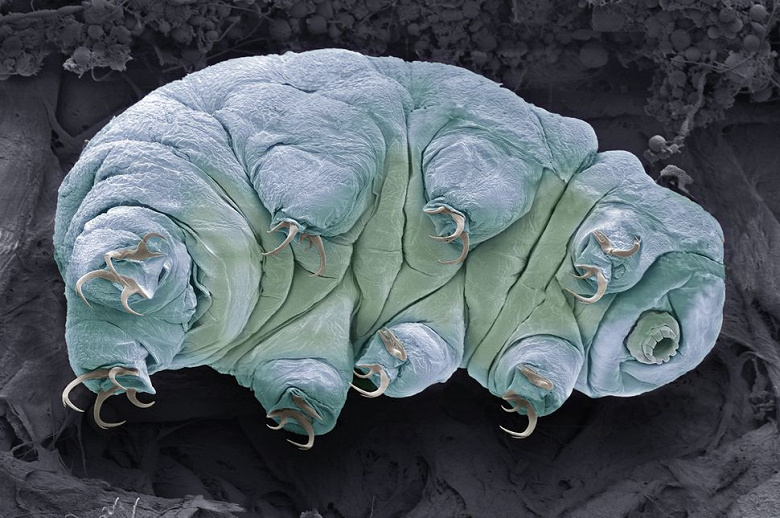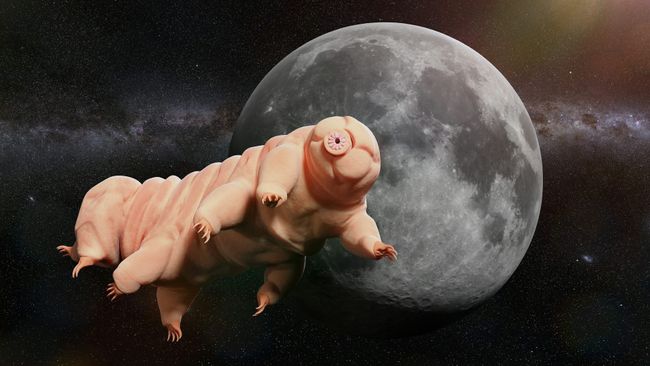Did the incredible resistance of tardigrades to extreme conditions help them survive on the Moon?
February 22, 2019, the Beresheet space probe was launched into lunar orbit. This lunar lander, created by SpaceIL and Israel Aerospace Industries, was intended to be the first private spacecraft to make a soft landing on the surface of the Earth's satellite. Among the payload were tardigrades, known for their ability to survive in the most extreme environments.
However, from the very beginning of the mission, problems arose due to the failure of the cameras needed to determine the orientation of the spacecraft and thus correctly control its engines. Initial budgetary constraints led to a simplification of the design, which also affected the landing: on April 11, the day of the planned landing, the situation became even more complicated. The spacecraft was moving at high speed; in order to attempt a successful soft landing, it had to slow down significantly. However, during this maneuver, the gyroscope, responsible for the proper functioning of the main engine, failed. As a result, at an altitude of 150 meters, the probe continued to move at a speed of about 500 km/h, which turned out to be too fast for timely speed adjustment. As a result of the strong impact, Beresheet shattered into pieces, which scattered over a radius of about one hundred meters. This was helped by NASA's Lunar Reconnaissance Orbiter satellite, which photographed the crash site on April 22.
Given their incredible ability to adapt to even the most extreme conditions, could tardigrades survive on the surface of the Moon and perhaps colonize it?
Tardigrades — microscopic animals, their size does not exceed a few millimeters. They have neurons, a mouth opening at the end of a retractable proboscis, an intestine with microbiota and four pairs of jointed legs ending in claws; most of the tardigrades have two eyes. They share a common ancestor with arthropods such as insects and arachnids.
Although most tardigrades live in aquatic environments, they can be found in any environment, including urban environments. For example, Emmanuel Delagoute, a CNRS researcher, discovers these creatures in the mosses and lichens of the Botanical Garden in Paris. To maintain vital functions, receive nutrition from microalgae such as chlorella, and move, grow and reproduce, tardigrades need to be surrounded by a film of water. They can reproduce both sexually and asexually through parthenogenesis (the formation of offspring from an unfertilized egg) or hermaphroditism, when an individual possesses both male and female gametes and can self-fertilize. After hatching from the egg, the active phase of life of tardigrades lasts from 3 to 30 months. There are 1,265 known species of these creatures, including two fossils.
Tardigrades are known to be resilient to conditions not found on Earth or the Moon. They are able to stop their metabolism, losing up to 95% of the water in the body. Some species synthesize the sugar trehalose («resurrection sugar»), which acts as an antifreeze, while others synthesize proteins that incorporate cellular components into an amorphous «glassy» a network that provides stability and protection to every cell. During dehydration, the body of a tardigrade can shrink by half, its legs dry out and only its claws remain visible. This condition, known as cryptobiosis, persists until conditions become favorable again.
Depending on the species of tardigrade, individuals require more or less time to dehydrate, and not all specimens of the same species manage to return to life. Dehydrated adults are able to survive for several minutes at temperatures ranging from -272°C to 150°C, and for long periods at high doses of gamma rays ranging from 1000 to 4400 Gray. For comparison: a dose of 10 Gy is lethal for humans, and 40-50,000 Gy sterilizes all types of materials. However, no matter the dose, radiation kills tardigrade eggs. Moreover, the protection provided by cryptobiosis does not always work, as is the case with the species Milnesium tardigradum.

So, what happened to the tardigrades after they ended up on the Moon? Are there still viable individuals among them, buried under the lunar regolith, the depth of which varies from several meters to several tens of meters?
Laboratory tests showed that when frozen specimens of Hypsibius dujardini struck sand at a speed of 3000 km/h, they suffered fatal damage. However, they survived impacts at speeds of 2600 km/h and below. The lunar landing was significantly slower, which may have increased the tardigrades' chances of survival.
Robert Wimmer-Schweingruber, a professor at the University of Kiel in Germany, and his team showed that the doses of gamma rays hitting the lunar surface are constant but low compared to the doses mentioned above – A 10-year exposure to gamma rays would correspond to a total dose of about 1 Gy. Although the lunar surface provides no protection from cosmic radiation, tardigrades are able to withstand the low and constant doses of gamma rays found on the Moon. However, conditions on the Moon, such as lack of water and significant differences in temperature — -170°C to -190°C on a moonlit night and from 100°C to 120°C during the day, pose serious challenges to possible colonization.
Today it is believed that tardigrades were not able to overcome all the harsh conditions of the Moon. Due to the lack of liquid water, oxygen and microalgae, they will not be able to reactivate, much less reproduce. Thus, it is believed that colonization of the Moon by tardigrades is impossible.
At the same time, the presence of inactive samples that may be in lunar soil raises ethical questions and requires deeper discussion. Modern space exploration is developing in all directions and requires maintaining the purity of other planets to be able to detect and study extraterrestrial life.
On the other hand, research and experiments with tardigrades on the Moon are still of scientific interest, as they can help understand the mechanisms of survival and adaptation to the extreme conditions of the studied planets and satellites.

